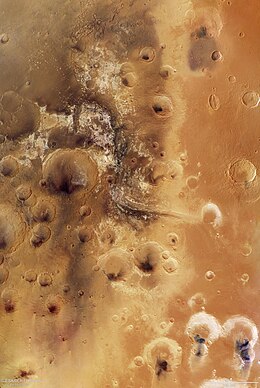Mawrth Vallis
 |
|
| Coordinates | 22°36′N 16°30′W / 22.6°N 16.5°WCoordinates: 22°36′N 16°30′W / 22.6°N 16.5°W |
|---|---|
| Length | 636.0 km |
| Naming | Welsh word for "Mars". |
Mawrth Vallis (Welsh: [maurθ]) (Mawrth means "Mars" in Welsh) is a valley on Mars, located in the Oxia Palus quadrangle at 22.3°N, 343.5°E with an elevation approximately two kilometers below datum. Situated between the southern highlands and northern lowlands, the valley is a channel formed by massive flooding which occurred in Mars’ ancient past. It is an ancient water outflow channel with light-colored clay-rich rocks.
Prior to the selection of Gale Crater for the Mars Science Laboratory (MSL) Curiosity mission, Mawrth Vallis was considered as a potential landing site because of the detection of a stratigraphic section rich in clay minerals. Clay minerals have implications for past aqueous environments as well as the potential to preserve biosignatures, making them ideal targets for the search for life on Mars. Although Mawrth Vallis was not chosen as a landing target, there is still interest in understanding the mineralogy and stratigraphy of the area. Until a rover mission is committed to exploring Mawrth Vallis, orbiters remain the only source of information. These orbiters consist of a number of spectrometers that contribute to our knowledge of Mawrth Vallis and the rest of the Martian surface.
One of the oldest valleys on Mars, Mawrth Vallis holds special interest because of the presence of phyllosilicate (clay) minerals which form only if water is available, first identified in data from the OMEGA spectrometer on the European Space Agency's Mars Express orbiter. Mars Reconnaissance Orbiter's Compact Reconnaissance Imaging Spectrometer for Mars has identified aluminium-rich and iron-rich clays, each with a unique distribution. Some of the clays recently discovered by the Mars Reconnaissance Orbiter are montmorillonite and kaolinite, and nontronite. Since some clays seem to drape over high and low areas, it is possible that volcanic ash landed in an open body of water. On Earth such clays occur in (among other environments) weathered volcanic rocks and hydrothermal systems, where volcanic activity and water interact. Mawrth Vallis was at one point considered as a landing site for the Mars Science Laboratory, which ultimately landed at Gale Crater. Clay minerals easily preserve microscopic life on Earth, so perhaps traces of ancient life may be found at Mawrth. It is considered a potential landing site for the Mars 2020 rover.
...
Wikipedia
